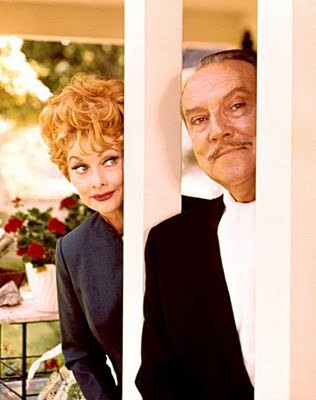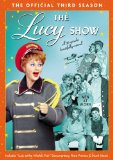| Reviews & Columns |
|
Reviews DVD TV on DVD Blu-ray 4K UHD International DVDs In Theaters Reviews by Studio Video Games Features Collector Series DVDs Easter Egg Database Interviews DVD Talk Radio Feature Articles Columns Anime Talk DVD Savant Horror DVDs The M.O.D. Squad Art House HD Talk Silent DVD
|
DVD Talk Forum |
|
|
| Resources |
|
DVD Price Search Customer Service #'s RCE Info Links |
|
Columns
|
|
|
Lucy Show - The Official Third Season, The
The Lucy Show in particular went through myriad and often confusing changes throughout its run while its immediate follow-up, Here's Lucy, prompted by Desilu's sale to Paramount Pictures, is virtually The Lucy Show with yet more alternations. During The Lucy's Show's first season, filmed in black and white, Lucy Carmichael (Ball) was a Danfield, New York-based widow, sharing her big house (and household expenses) with pal Vivian Bagley (Vance), television's first (continuing character) divorcée. Both had children: Lucy had a teenage daughter, Chris (Candy Moore), and a precocious son, Jerry (Jimmy Garrett), while "Viv" had a son about Jerry's age, Sherman (Ralph Hart). Comedian Dick Martin, sans partner Dan Rowan, played Lucy's next-door neighbor and potential love interest Harry, a commercial pilot (an antecedent to Bill Dailey's pilot-neighbor on The Bob Newhart Show). Cantankerous banker Mr. Barnsdahl (Charles Lane) officiously managed Lucy's estate.
By The Official Third Season, The Lucy Show was changing dramatically, moving away from its early promise as something at least a little bit different, soon locking itself into the kind of formula slapstick (frequently bolstered by the appearance of big-name Hollywood stars) Ball assiduously clung to for the remainder of her career.
As with all other official Ball series on DVD, The Lucy Show - The Official Third Season is a superbly annotated collection of episodes crammed with affectionate and informative extra features. And as with Here's Lucy, for many decades I didn't much care for The Lucy Show; I Love Lucy is much better and my hazy memory is that the later Lucy Shows are particularly weak. Revisiting them on DVD after so many years, I confess to now finding both later series pleasant and moderately funny (usually with at least one laugh-out-loud gag in every episode), while Ball's unquestionable professionalism and commitment to the script's wild sight gags, in which she always gives her all (as opposed to being naturally funny, which Ball was not) continues to impress. Even if you don't love Lucy, chances are the set and its extras will impress viewers with their affectionate thoroughness.
The third season is quite different from the first. For starters, both Dick Martin and Charles Lane are out. Martin was never anything but an odd fit for a show like this, especially as Lucy's sometime love interest. (Martin was 11 years younger than Lucy and looked it - he always seemed younger than he actually was; Ball, a chain-smoker, aged prematurely, though in fairness her husband Gary Morton was even younger than Martin.) Lane was a good foil but apparently his strengths were with single-camera shows; reportedly he struggled adjusting to filming before live audiences and the notoriously perfectionist Lucy, who insisted upon polished, theater-like presentations of their half-hour comedies, replaced him with old friend and radio veteran Gale Gordon.
Vivian Vance was also on her way out. After playing second banana to Lucy for nearly 15 years, she wanted to spend more time with her family in Connecticut. Beginning this season, she limited her appearances to 20 of the season's 26 shows and quit thereafter, returning only for the rare guest appearance. The addition of Gordon, a broader comic actor who held his own against Ball's high-key clowning, and with Vance's screentime severely lessened, The Lucy Show dramatically shifted in tone. One symptom of this was the Carmichael and Bagley kids; with nary any explanation they simply vanished, especially Viv's son, Sherman.
Another of Lucy's real-life pals, Ann Sothern, who'd guested on a Lucy-Desi Comedy Hour some years back, essentially took over Vance's slot for several episodes (coincidentally just as production began on the very first Star Trek pilot on Desilu's stages next-door) before Ball settled on another backstage associate, actress Mary Jane Croft (also producer Elliott Lewis's wife), as Lucy's new pal. But Croft, an appealing if more typical and poised middle-aged woman whose screen persona would've fit just about any sitcom, was never the reluctant co-conspirator, waist-deep in the mud sidekick Vance had been. No one would ever replace her; no one could. Vance was one of a kind.
Gordon's blustery Mr. Mooney was anything but subtle; on the other hand, only Arnaz and Vance were his equals playing opposite - and keeping up with - the comedienne's wildest antics. He knew how to milk a gag, especially his exaggerated umbrage, embarrassment, and continually shattered dignity. Ball knew a good thing when she saw it; Ball's untalented second husband, Borscht Belt stand-up comedian-turned executive Gary Morton, became something of a joke at Desilu, a pale successor to genius workaholic Desi (who left The Lucy Show during season two), but Ball knew Gordon was worth his weight in gold.
However, Gordon's enhanced role on The Lucy Show directly shifted Ball's character away from the spunky widow devoted to her two children while looking for husband and new ways to earn money and into something of a Henna-haired moron. Sparring (and, later, working) for banker Mr. Mooney, Lucy Carmichael eventually devolved into a stargazing dingbat.
Further, Ball gradually dropped her most-trusted writers, most of whom dated back to the earliest days of I Love Lucy: Bob Carroll, Jr., Madelyn (Pugh Davis) Martin, Bob Schiller, and Bob Weiskopf. Instead, a steady stream of sitcom scribes came and left, including former Dick Van Dyke Show contributor Garry Marshall (whose Laverne & Shirley owes much to The Lucy Show), and the series became increasingly formula-driven.
Finally, while it originally aired in black and white, the third season of The Lucy Show, like the previous year, was filmed in color though first broadcast in black & white. (The 1966-67 primetime lineup season was the first all-color season, and Ball was all but certain The Lucy Show would have rerun value well past that time.) In color the episodes look great; viewers have the options of viewing the original network opening and closing titles (noting that week's sponsors), which are in monochrome.
But, straddling both worlds as it were, this third season - while inconsistent - has more than its share of hard-earned laughs. Guest stars - with many of the lesser-known character actors part of the show's unofficial stock company - include Charles Drake (a better-cast boyfriend than Martin), Ray Kellogg, Jack Benny, Bob Hope, Willard Waterman, Keith Andes, Max Showalter, Fifi D'Orsay, John Williams, Lloyd Corrigan, Harvey Korman, Madge Blake, Parley Baer, Jack Kelly, Alan Carney, Cliff Norton, Hal Smith, Kathleen Freeman, Norma Varden, Mabel Anderson, Nestor Paiva, Herb Vigran, Danny Kaye, Jim Davis, Dick Winslow, the aforementioned Ann Sothern, Reta Shaw, Byron Foulger, Carole Cook, Norman Leavitt, Arthur Godfrey, Dick Patterson, Tommy Farrell, Steven Geray, Elliott Reid, and Pat Harrington. Classic monster fans take note: "Lucy and the Monsters" features George (Robot Monster) Barrows, Bob Burns, Shep Sanders, and Sid Haig as, respectively, a gorilla, a werewolf, Count Dracula, and the Mummy.
Video & Audio
The Lucy Show is presented in its original full-frame format in terrific-looking color (and black & white transfers), with the episodes spread over four single-sided, dual layered DVDs. Episode titles with brief descriptions and airdates are offered as part of the packaging. In a neat touch, viewers have the option to watch episodes in their familiar syndicated versions or in "vintage" edits - with their original, extended opening and closing titles (albeit in black & white, per their network versions), which feature both black & white and color highlights from previous episodes. Not all shows have this option but many do. The English-only mono, which is not subtitled per se but is closed captioned, sounds great on the syndicated versions, but less so in their "vintage" counterparts, which were partly sourced from 16mm prints. A note in .0001 type states "Music has been changed for this home entertainment version" but I didn't notice anything in particular.
Extra Features.
Disc one includes "Lucy at the World's Fair," with comments by Albert Fisher about August 31, 1964, "Lucy Day" (mostly silent footage includes Hedda Hopper, Morton and Dede, Ball's mother) at the New York World's Fair, including its full-size replica of Grauman's Chinese Theater. It's as fascinating for its footage of the fair as it is for Lucy's appearance. A "mementos" supplement adds to the fun. As with most of the new extras, it's hosted by Tony Maietta.
Maietta also introduces "Lucy and the Plumber" but I'd advise against watching it until after viewing the episode, as it's shamelessly filled with spoilers. A cast commercial (for Lux Beauty Soap) is included.
I found the production notes, noting numerous in-jokes and flubs, particularly interesting, such as the fact that, quite unusual for series television, production on the third season began in early May 1964, giving The Lucy Show a seven-episode head-start on the new season. An extensive photo gallery, like the production notes, is also included on all four discs.
Disc two includes "Meet Maury Gertsman," a text bio of the series' director of photography, while disc three includes clips from Lucy's 1964 appearance (on black and white videotape) on The Danny Kaye Show, an example of Ball's longstanding you-scratch-my-back guest star-exchange program.
Disc four includes a series of international promos for The Lucy Show, some with film but no audio, others vice versa. Included are promos for the BBC, broadcasts in French, German, and Spanish, and airings in the Philippines, Singapore, and elsewhere. Also included are show excerpts dubbed into French and Japanese (the latter uncannily captures Ball's cadence). The disc also includes a text profile of costume designer Eddie Stevenson, and includes some of his sketches for the series.
Parting Thoughts
The Lucy Show - The Official Third Season is lightweight but very entertaining, and the supplements and attractive color transfers really won this reviewer over. Highly Recommended.
Film historian Stuart Galbraith IV's latest book, Japanese Cinema, is on sale now.
|
| Popular Reviews |
| Sponsored Links |
|
|
| Sponsored Links |
|
|
| Release List | Reviews | Shop | Newsletter | Forum | DVD Giveaways | Blu-Ray | Advertise |
|
Copyright 2024 DVDTalk.com All Rights Reserved. Legal Info, Privacy Policy, Terms of Use,
Manage Preferences,
Your Privacy Choices | |||||||















